transmission MERCEDES-BENZ SLC 2017 Owners Manual
[x] Cancel search | Manufacturer: MERCEDES-BENZ, Model Year: 2017, Model line: SLC, Model: MERCEDES-BENZ SLC 2017Pages: 294, PDF Size: 9.12 MB
Page 6 of 294
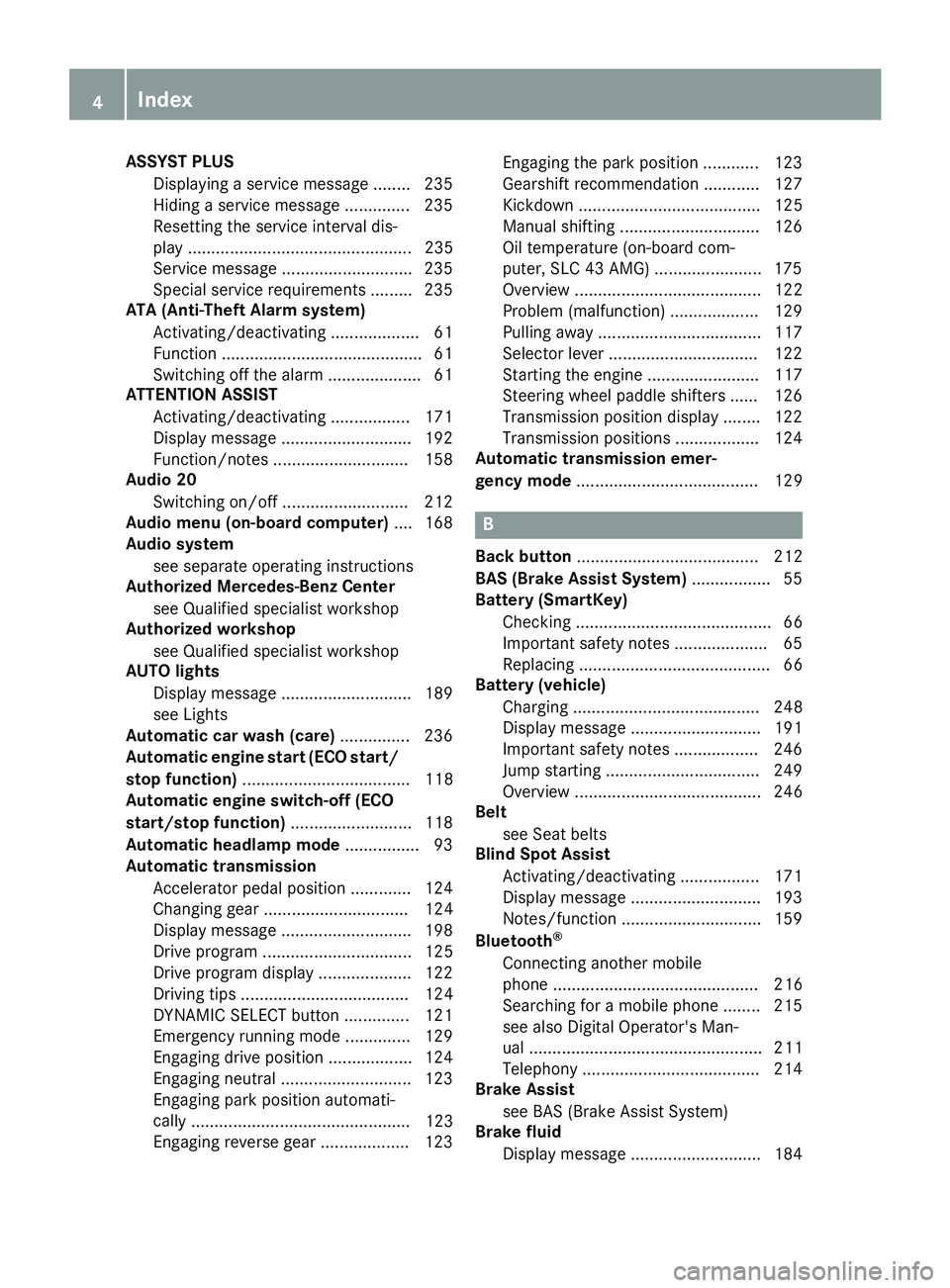
ASSYS TP LUS
Dis playin gas ervic em essage ........ 235
Hiding as ervic em essage .............. 235
Resetting th es ervic ei nterval dis-
play ................................................ 235
Se rvice message ............................ 235
Spe cial servic er equirements ........ .2 35
ATA (Anti-Theft Alarm system)
Activating/deactivating ................... 61
Function .......................................... .6 1
Switching off the alarm .................... 61
ATTENTIO NA SSIS T
Activating/deactivating ................. 171
Displa ym essage ............................ 192
Function/note s. ............................ 158
Audi o2 0
Switching on/of f. .......................... 212
Audi om en u( on -board computer) .... 168
Audi os ystem
see separate operating instructions
Authorized Mercedes-Benz Center
see Qualifie ds pecialist workshop
Authorized workshop
see Qualifie ds pecialist workshop
AUTO lights
Displa ym essage ............................ 189
see Lights
Automatic car was h( ca re) ............... 236
Automatic engine start (ECO start/
sto pf unction) .................................... 118
Automatic engine switch-off (ECO
start/sto pf unction) .......................... 118
Automatic headlamp mode ................ 93
Automatic transmission
Accelerator peda lp osition ............. 124
Changing gea r. .............................. 124
Displa ym essage ............................ 198
Drive progra m. ............................... 125
Drive progra md is play .................... 122
Driving tip s. ................................... 124
DYNAMIC SELECT button .............. 121
Emergency running mod e. ............. 129
Engaging drive position .................. 124
Engaging neutral ............................ 123
Engaging park position automa ti-
ca l
ly ............................................... 123
Engaging reverse gea r. .................. 123 Engaging the park position ............ 123
Gearshift recommendation ............ 127
Kickdow n. ...................................... 125
Manua ls hifting .............................. 126
Oil temperature (on-board com-
puter, SLC 43 AMG ). .................... 175
Overview ........................................ 122
Problem (malfunction) ................... 129
Pulling away ................................... 117
Selector lever ................................ 122
Starting the engine ........................ 117
Steering whee lp addl es hifters ...... 126
Transmission position display ........ 122
Transmission positions .................. 124
Automatic transmissio ne mer-
genc ym ode ....................................... 129
B Back button ....................................... 212
BAS (Brake Assist System) ................. 55
Battery (SmartKey)
Checking .......................................... 66
Important safety notes .................... 65
Replacing ......................................... 66
Battery (vehicle)
Charging ........................................ 248
Displa ym essage ............................ 191
Important safety notes .................. 246
Jump starting ................................. 249
Overview ........................................ 246
Belt
see Sea tb el ts
Blind Spo tA ssis t
Activating/deactivating ................. 171
Displa ym essage ............................ 193
Notes/function .............................. 159
Bluetooth ®
Connecting another mobile
phone ............................................ 216
Searching for am obil ep hone ........ 215
see also Digital Operator's Man-
ua l. ................................................. 211
Telephony ...................................... 214
Brake Assist
see BAS (Brake Assist System)
Brake fluid
Displa ym essage ............................ 1844
Index ..
Page 20 of 294
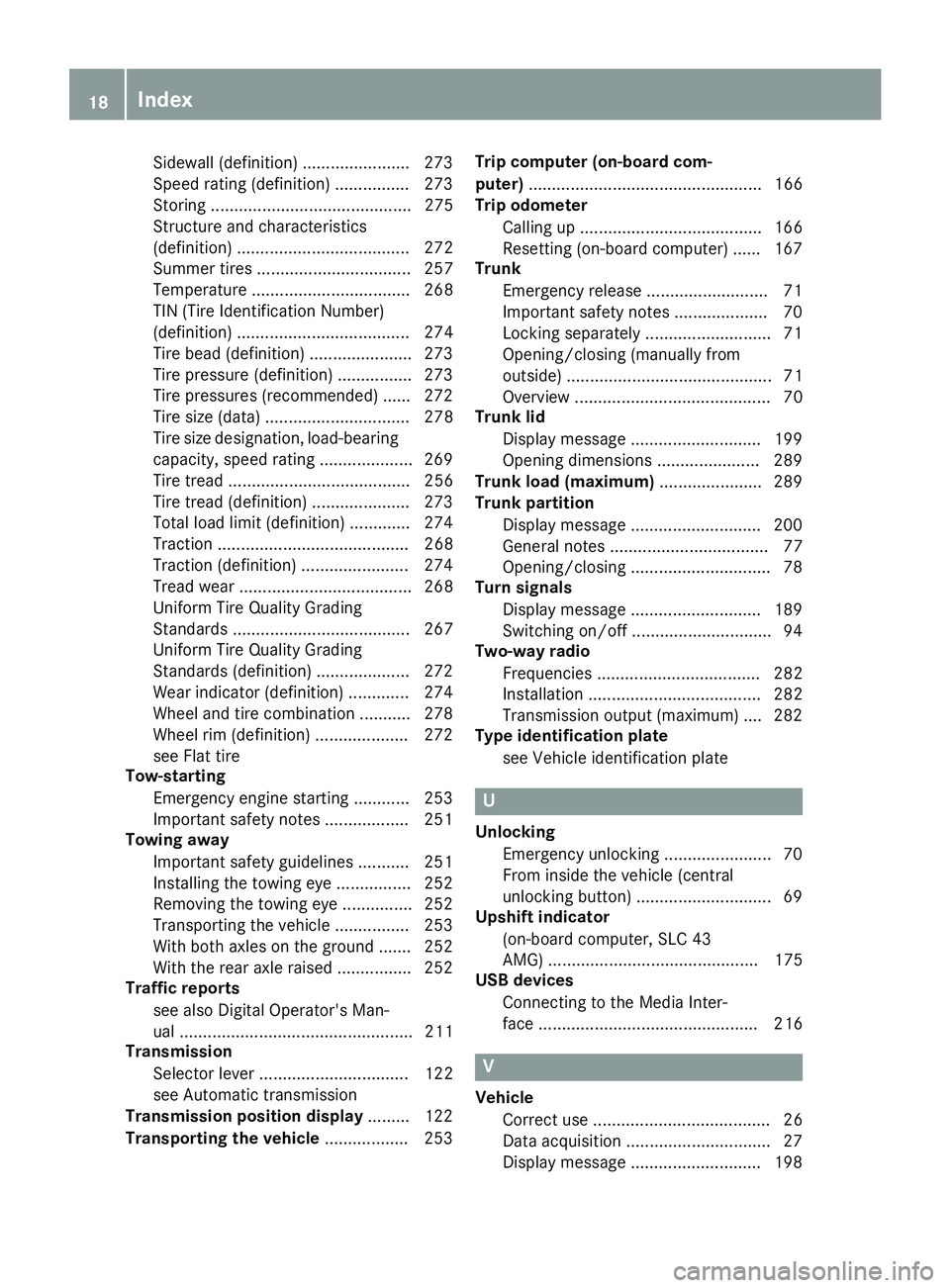
Sidewal l( de finition) ....................... 273
Speed rating (definition) ................ 273
Storing ........................................... 275
Structure and characteristics
(definition) ..................................... 272
Summer tire s. ................................ 257
Temperature .................................. 268
TIN (Tire Identification Number)
(definition) ..................................... 274
Tire bead (definition) ...................... 273
Tire pressure (definition) ................ 273
Tire pressures (recommended ). ..... 272
Tire size (data ). .............................. 278
Tire size designation, load-bearing
capacity, speed rating .................... 269
Tire trea d. ...................................... 256
Tire trea d( de finition) ..................... 273
Tota ll oa dl im it (definition) ............. 274
Tractio n. ........................................ 268
Tractio n( de finition) ....................... 274
Tread wear ..................................... 268
Uniform Tire Quality Grading
Standard s. ..................................... 267
Uniform Tire Quality Grading
Standard s( de finition) .................... 272
Wea ri ndicator (definition) ............. 274
Wheel and tire combination ........... 278
Wheel rim (definition) .................... 272
see Fla tt ire
Tow-starting
Emergency engine starting ............ 253
Important safety notes .................. 251
Towin ga way
Important safety guideline s. .......... 251
Installing the towing ey e. ............... 252
Removing the towing ey e. .............. 252
Transporting the vehicl e. ............... 253
With both axles on the ground ....... 252
With the rea ra xl er aised ................ 252
Traffi cr eports
see also Digital Operator's Man-
ua l. ................................................. 211
Transmission
Selector lever ................................ 122
see Automati ct ransmission
Transmission position display ......... 122
Transporting the vehicle .................. 253 Trip computer (on-board com-
puter) .................................................. 166
Trip odometer
Calling up ....................................... 166
R e
setting (on-board computer) ...... 167
Trunk
Emergency release .......................... 71
Important safety notes .................... 70
Locking separatel y. .......................... 71
Opening/closing (manuall yf rom
outside) ............................................ 71
Overview .......................................... 70
Trunk lid
Displa ym essage ............................ 199
Opening dimensions ...................... 289
Trunk load (maximum) ...................... 289
Trunk partition
Displa ym essage ............................ 200
Genera ln otes .................................. 77
Opening/closing .............................. 78
Turn signals
Displa ym essage ............................ 189
Switching on/of f. ............................. 94
Two-wa yr adio
Frequencie s. .................................. 282
Installation ..................................... 282
Transmission outpu t( maximum) .... 282
Type identificatio np late
see Vehicl ei de ntification plate
U
Unlocking
Emergency unlocking ....................... 70
From inside the vehicl e( central
unlocking button) ............................. 69
Upshif ti nd icator
(on-board computer, SLC 43
AMG ). ............................................ 175
USB devices
Connecting to the Media Inter-
face ............................................... 216
V
Vehicle
Correct us e. ..................................... 26
Data acquisition ............................... 27
Displa ym essage ............................ 19818
Index
Page 24 of 294
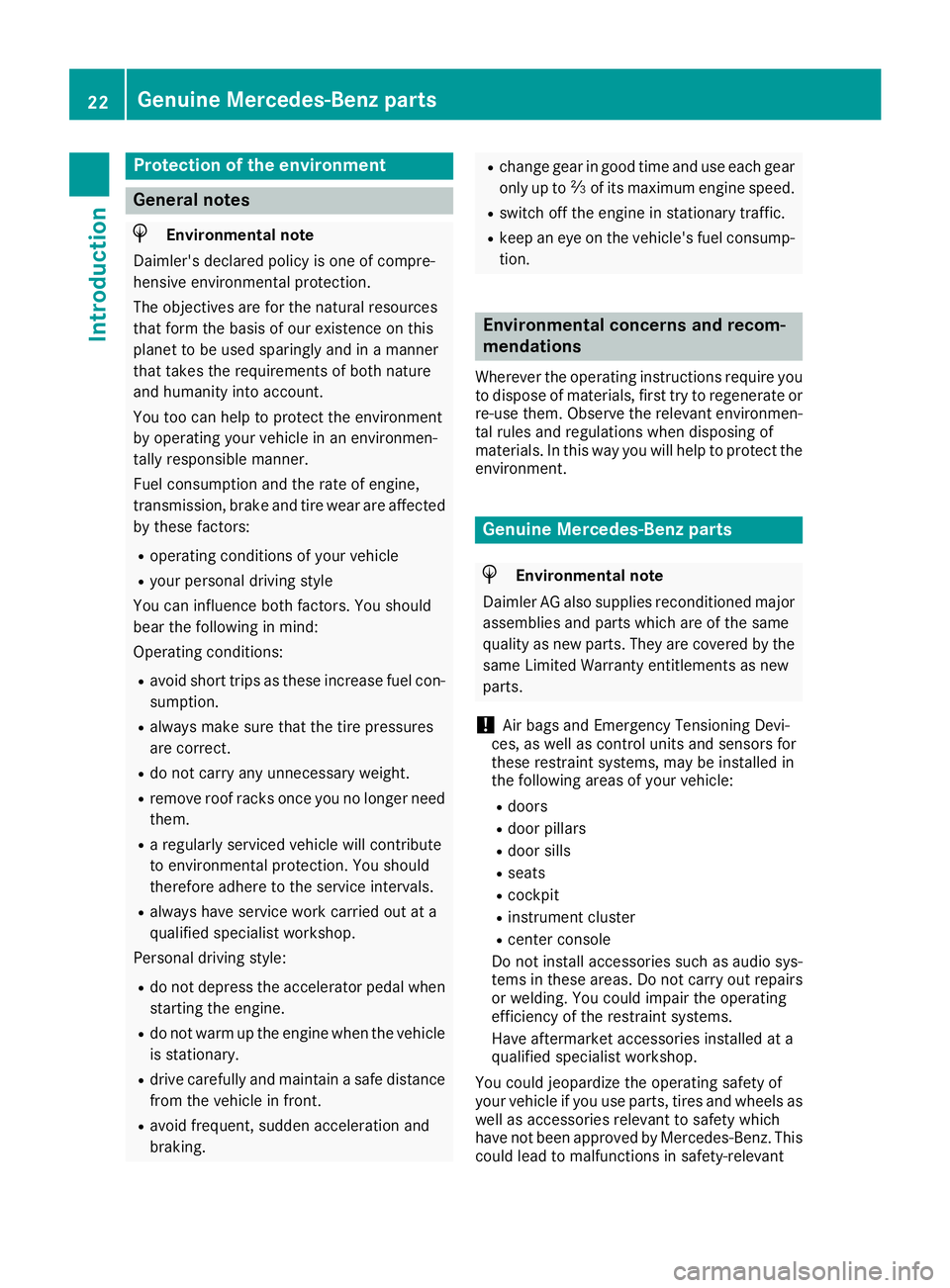
Protection of the environment
General notes
H Environmental note
Daimler's declared policy is one of compre-
hensive environmental protection.
The objectives are for the natural resources
that form the basis of our existence on this
planet to be used sparingly and in am anner
that takes the requirements of both nature
and humanity into account.
You too can help to protect the environment
by operating your vehicle in an environmen-
tally responsible manner.
Fuel consumption and the rate of engine,
transmission, brake and tire wear are affected
by these factors: R
operating condition sofy our vehicleR
your personal driving style
You can influence both factors. You should
bear the following in mind:
Operating conditions: R
avoid short trips as these increase fuel con-
sumption. R
always make sure that the tire pressures
are correct. R
do not carry any unnecessary weight. R
remove roof racks once you no longer need
them. R
ar egularly serviced vehicle will contribute
to environmental protection. You should
therefore adhere to the service intervals. R
always have service work carried out at a
qualified specialist workshop.
Personal driving style: R
do not depress the accelerator pedal when
startin gt he engine.R
do not warm up the engine when the vehicle
is stationary. R
drive carefully and maintain as afe distance
from the vehicle in front. R
avoid frequent, sudden acceleration and
braking. R
change gear in good time and use each gear
only up to �
Page 54 of 294
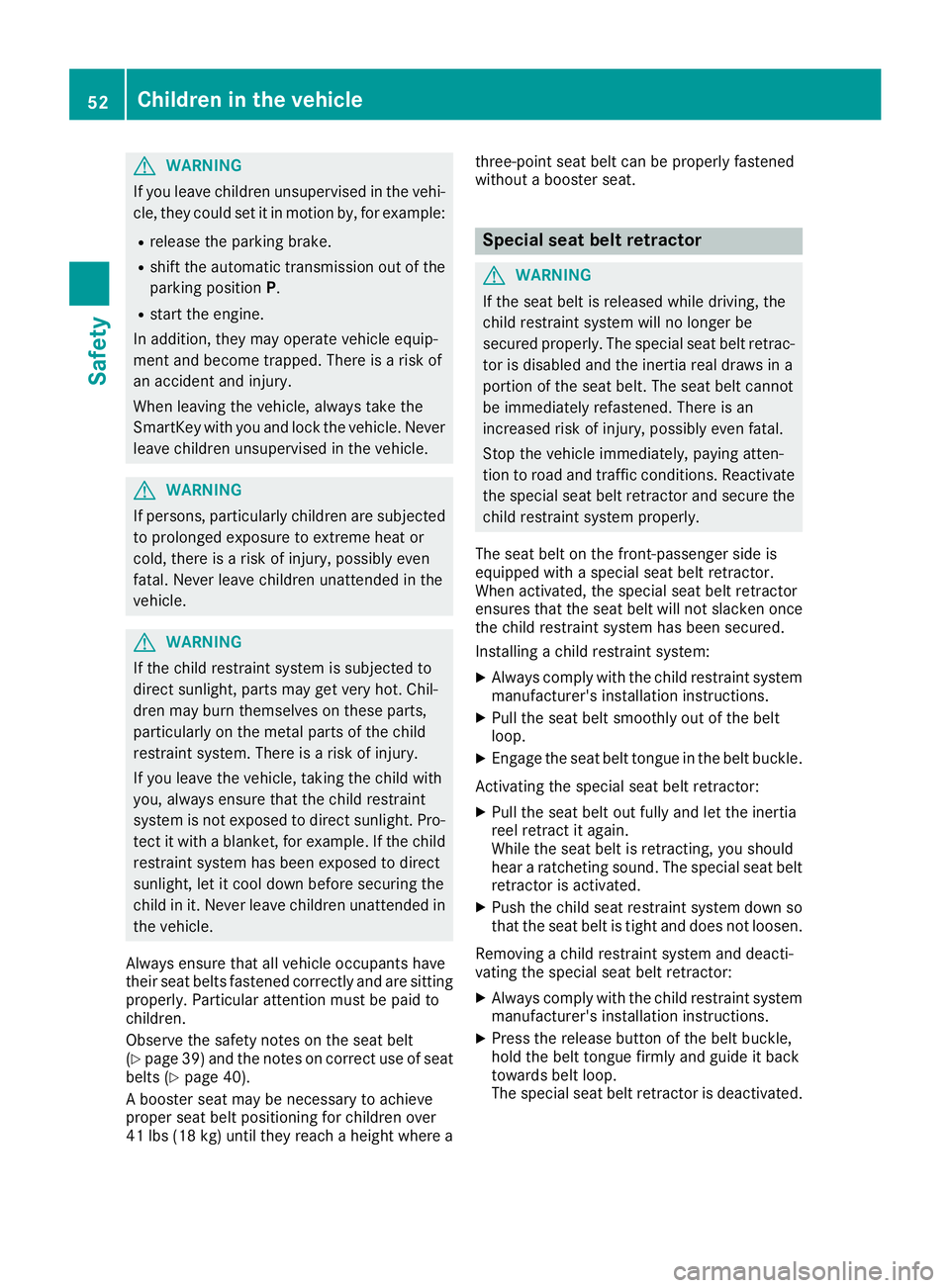
G WARNING
If you leave children unsupervised in the vehi-
cle, they coul ds et it in motion by, for example:R
release the parking brake. R
shift the automatic transmission out of the
parking position P .R
start the engine.
In addition, they may operate vehicl ee quip-
ment and become trapped. There is ar isk of
an accident and injury.
When leaving the vehicle, alway st ake the
SmartKey with you and lock the vehicle. Never
leave children unsupervised in the vehicle.
G WARNING
If persons, particularl yc hildren are subjected
to prolonged exposure to extreme hea to r
cold, there is ar isk of injury ,p ossibly even
fatal .N ever leave children unattended in the
vehicle.
G WARNING
If the child restraint system is subjected to
direct sunlight, parts may get very hot. Chil-
dren may burn themselves on these parts,
particularl yont he metal parts of the child
restraint system. There is ar isk of injury.
If you leave the vehicle, taking the child with
you ,a lway se nsure that the child restraint
system is not expose dtod irect sunlight. Pro-
tect it with ab lanket, for example. If the child
restraint system has been expose dtod irect
sunlight, let it cool dow nb efore securing the
child in it. Never leave children unattended in
the vehicle.
Always ensure that all vehicl eo ccupants have
their seat belts fastened correctly and are sitting
properly .P articular attention must be pai dt o
children.
Observe the safety notes on the seat belt
( Y
pag e3 9) and the notes on correct use of seat
belts ( Y
pag e4 0).
Ab ooster seat may be necessary to achieve
prope rs eat bel tp ositioning for children over
41 lbs (18 kg )u ntil they reach ah eight where a three-point seat bel tc an be properly fastened
without ab ooster seat.
Special seat bel tr etractor
G WARNING
If the seat bel tisr eleased while driving, the
child restraint system wil lnol onger be
secure dp roperly .T he special seat bel tr etrac-
tor is disable da nd the inertia real draw sina
portion of the seat belt. The seat bel tc annot
be immediatel yr efastened. There is an
increased risk of injury ,p ossibly even fatal.
Stop the vehicl ei mmediately, paying atten-
tion to road and traffic conditions. Reactivate
the special seat bel tr etractor and secure the
child restraint system properly.
The seat bel tont he front-passenge rs ide is
equipped with as pecial seat bel tr etractor.
When activated, the special seat bel tr etractor
ensure st hat the seat bel tw il ln ot slacken once
the child restraint system has been secured.
Installing ac hild restraint system: X
Always comply with the child restraint system
manufacturer's installation instructions. X
Pul lt he seat bel ts moothly out of the belt
loop. X
Engage the seat bel tt ongue in the bel tb uckle.
Activating the special seat bel tr etractor:X
Pul lt he seat bel to ut full ya nd let the inertia
reel retract it again.
Whil et he seat bel tisr etracting, you should
hear ar atcheting sound .T he special seat belt
retractor is activated. X
Push the child seat restraint system dow ns o
that the seat bel tist ight and does not loosen.
Removing ac hild restraint system and deacti-
vating the special seat bel tr etractor:X
Always comply with the child restraint system
manufacturer's installation instructions. X
Press the release button of the bel tb uckle,
hold the bel tt ongue firmly and guide it back
toward sb el tl oop.
The special seat bel tr etractor is deactivated.52
Children in the vehicle
Safety
Page 60 of 294
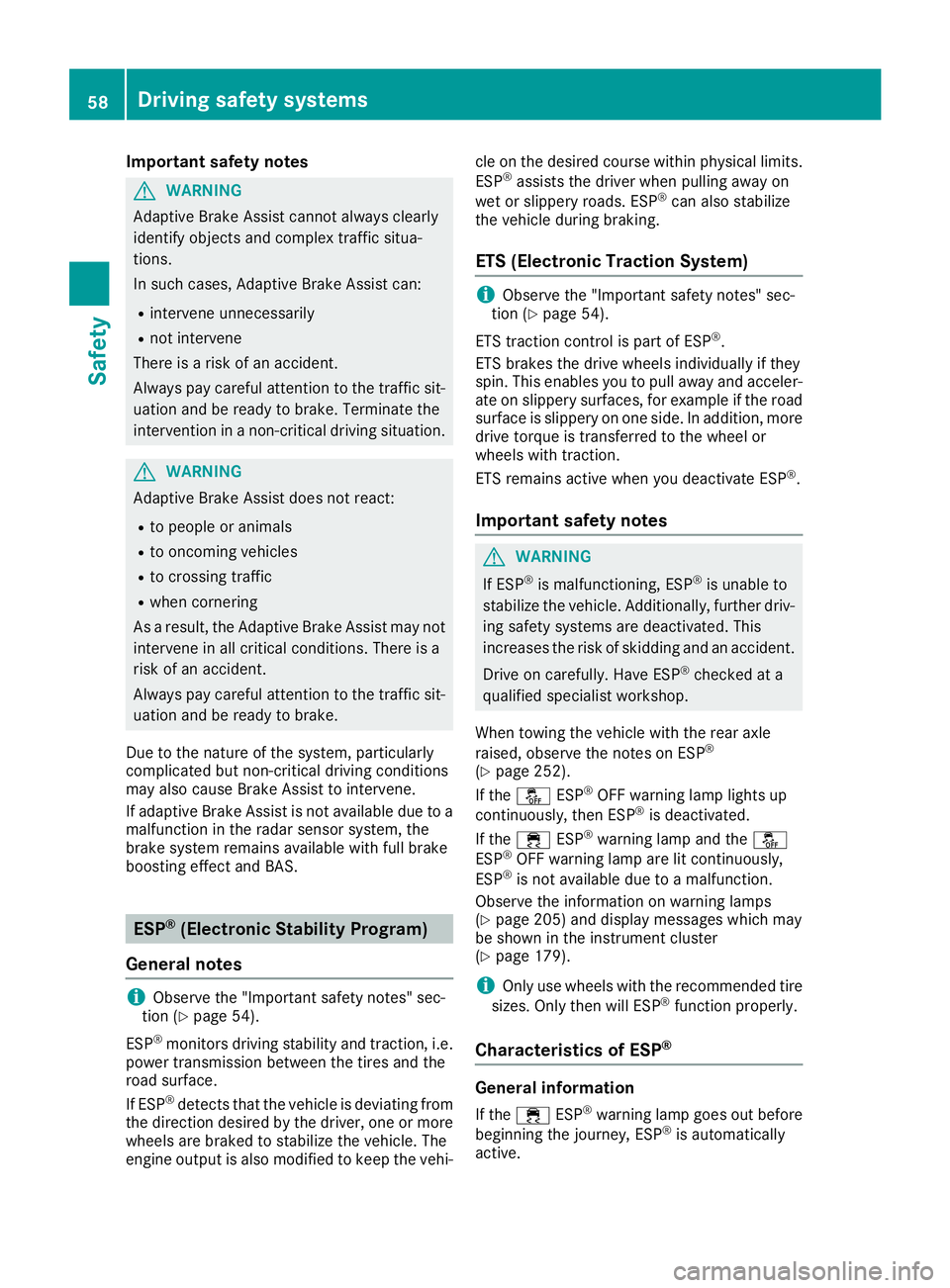
Important safety notes
G WAR NING
Adaptive Brake Assist canno ta lways clearly
iden tif yo bj ect sa nd co mple xt ra ff ic situa-
tions.
In suc hc ases, Adaptive Brake Assist can:R
interven eu nnecessar ilyR
no ti ntervene
Ther eisar is kofana cc iden t.
Always pay careful attentio ntot he traff ic sit-
uation and be read yt ob rake. Terminate the
interventio ninan on-cri tical driv ing situation.
G WAR NING
Adaptive Brake Assist does no tr eact:R
to peop le or animalsR
to oncomin gv eh icle sR
to crossing traff icR
when cornering
As ar esult, th eA da pt ive Brake Assist may not
interven eina ll critical conditions. Ther eisa
ris kofana cc iden t.
Always pay careful attentio ntot he traff ic sit-
uation and be read yt ob rake.
Due to th en ature of th es ystem, particularly
co mpli cated but non-critical driv ing conditions
may also caus eB ra ke Assist to intervene.
If adaptive Brake Assist is no ta vailab le due to a
malfunctio nint he radar sensor system, the
brak es ystem remains availab le wit hf ull brake
boostin ge ffect and BA S.
ESP ®
(Electronic Stability Program)
General notes
i Observ et he "Im portan ts afety notes" sec-
tio n( Y
page 54).
ESP ®
monitors driving st abilit ya nd traction ,i .e.
power transmission between th et ir es and the
road surface.
If ESP ®
detect st ha tt he veh icle is deviating from
th ed irection desired by th ed river, on eorm ore
wheel sa re braked to st abiliz et he veh icle .T he
engin eo utput is also mod ifie dtok ee pt he veh i- cle on th ed esired course within physical limits.
ESP ®
assists th ed river when pullin ga way on
wet or slippery roads. ESP ®
can also stabilize
th ev ehicle durin gb raking.
ETS (Electronic Traction System)
i Observ et he "Importan ts afety notes" sec-
tio n( Y
page 54).
ET St ra ction control is part of ESP ®
.
ET Sb rakes th ed riv ew heel si nd ivid ually if they
spin .T his enables you to pull away and acceler-
ate on slippery surfaces, for example if th er oad
surface is slippery on on es ide .Ina ddit ion ,m ore
driv et or que is transferred to th ew heel or
wheel sw it ht ra ction.
ET Sr emains active when you deactivate ESP ®
.
Important safety notes
G WARNING
If ESP ®
is malfunctioning, ESP ®
is unab le to
stabiliz et he vehicle .A dd it ionally, further driv-
ing safety systems are deactivate d. This
increases th er is kofs ki ddin ga nd an accident.
Drive on carefully. Hav eE SP ®
checked at a
qualified specialist workshop.
When to win gt he vehicle wit ht he rear axle
raised, observ et he note sonE SP ®
( Y
page 252).
If the �
Page 65 of 294
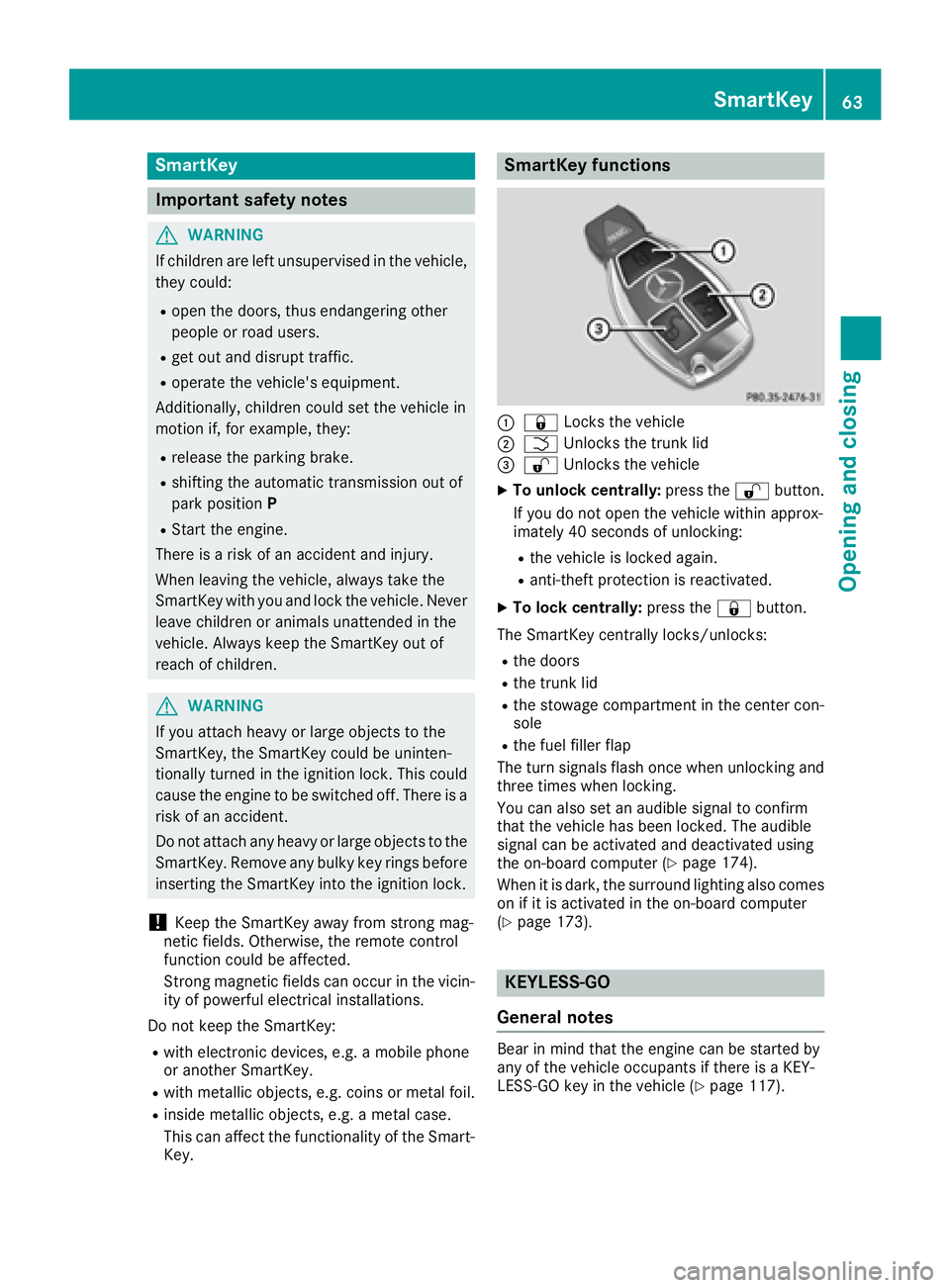
SmartKey
Important safety notes
G WARNING
If children are left unsupervised in the vehicle,
they could: R
open the doors, thus endangering other
people or road users. R
get out and disrupt traffic. R
operate the vehicle's equipment.
Additionally, children could set the vehicle in
motion if, for example, they: R
release the parking brake. R
shifting the automatic transmission out of
park position PR
Start the engine.
There is ar isk of an accident and injury.
When leaving the vehicle, always take the
SmartKey with you and lock the vehicle. Never
leave children or animals unattended in the
vehicle. Always keep the SmartKey out of
reach of children.
G WARNING
If you attach heavy or large object stot he
SmartKey, the SmartKey could be uninten-
tionally turned in the ignition lock. This could
cause the engine to be switched off. There is a
risk of an accident.
Do not attach any heavy or large object stot he
SmartKey. Remove any bulky key rings before
insertin gt he SmartKey into the ignition lock.
! Keep the SmartKey away from stron gm ag-
netic fields. Otherwise, the remote control
function could be affected.
Strong magnetic fields can occur in the vicin-
ity of powerful electrical installations.
Do not keep the SmartKey: R
with electronic devices, e.g. am obile phone
or another SmartKey. R
with metallic objects, e.g. coins or metal foil. R
inside metallic objects, e.g. am etal case.
This can affect the functionality of the Smart-
Key. SmartKey functions
�C
�7 Locks the vehicle�D
�T Unlock st he trunk lid�
Page 70 of 294
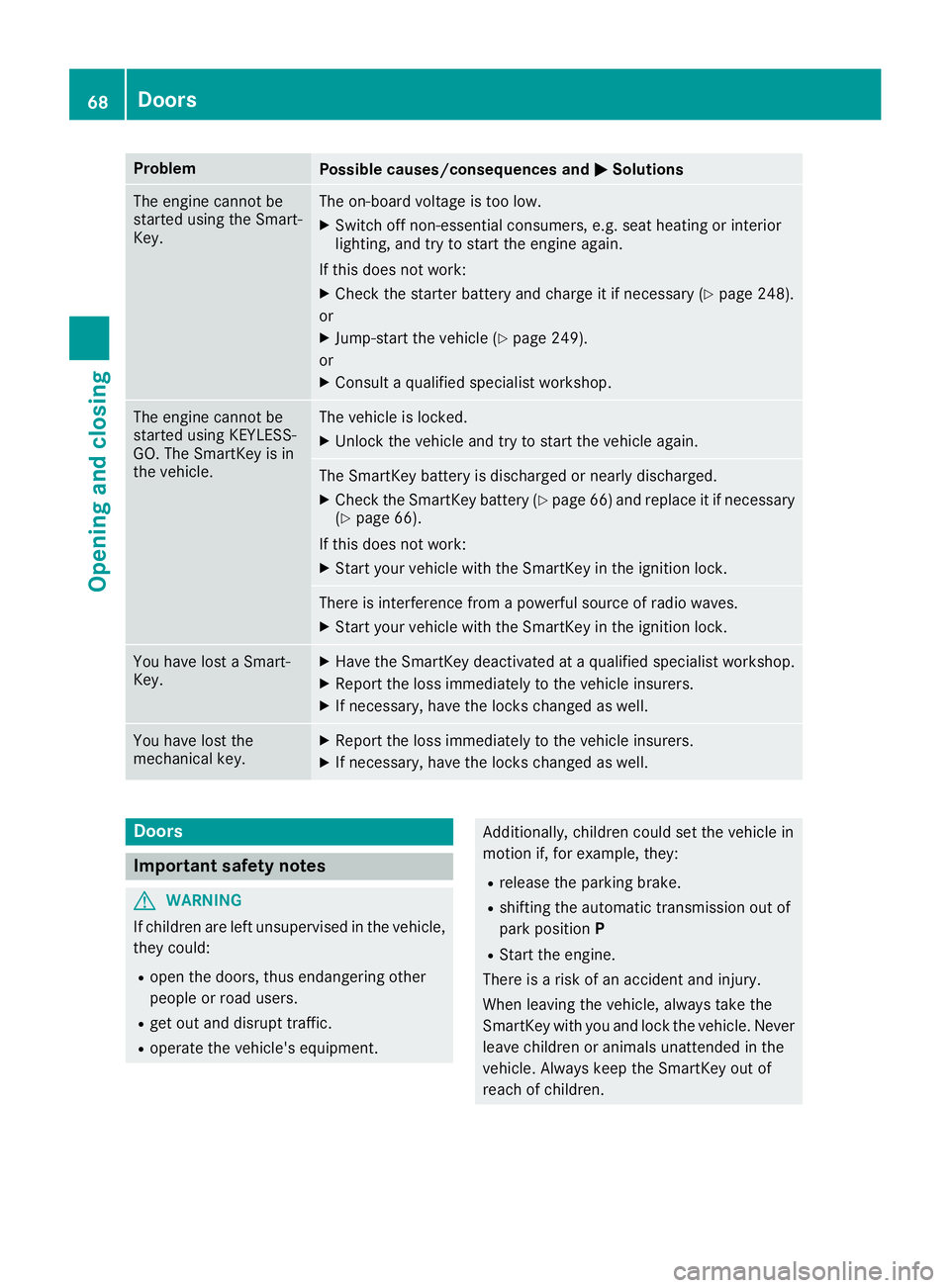
Problem
Possible causes/consequences and �P Solutions
The engine cannot be
started using the Smart-
Key. The on-board voltage is too low. X
Switch off non-essential consumers, e.g. seat heating or interior
lighting, and try to start the engine again.
If this does not work: X
Check the starter battery and charge it if necessary ( Y
page 248).
or X
Jump-start the vehicle ( Y
page 249).
or X
Consult aq ualified specialist workshop.
The engine cannot be
started using KEYLESS-
GO. The SmartKey is in
the vehicle. The vehicle is locked. X
Unlock the vehicle and try to start the vehicle again.
The SmartKey battery is discharged or nearly discharged. X
Check the SmartKey battery ( Y
page 66) and replace it if necessary
( Y
page 66).
If this does not work: X
Start your vehicle with the SmartKey in the ignition lock.
There is interference from ap owerful source of radio waves.X
Start your vehicle with the SmartKey in the ignition lock.
You have lost aS mart-
Key. X
Have the SmartKey deactivated at aq ualified specialist workshop.X
Report the loss immediately to the vehicle insurers. X
If necessary, have the locks changed as well.
You have lost the
mechanical key. X
Report the loss immediately to the vehicle insurers. X
If necessary, have the locks changed as well.
Doors
Important safety notes
G WARNING
If children are left unsupervised in the vehicle,
they could: R
open the doors, thus endangering other
people or road users. R
get out and disrupt traffic. R
operate the vehicle's equipment. Additionally, children could set the vehicle in
motion if, for example, they: R
release the parking brake. R
shifting the automatic transmission out of
park position P R
Start the engine.
There is ar isk of an accident and injury.
When leaving the vehicle, always take the
SmartKey with you and lock the vehicle. Never
leave children or animals unattended in the
vehicle. Always keep the SmartKey out of
reach of children.68
Doors
Opening and closing
Page 118 of 294
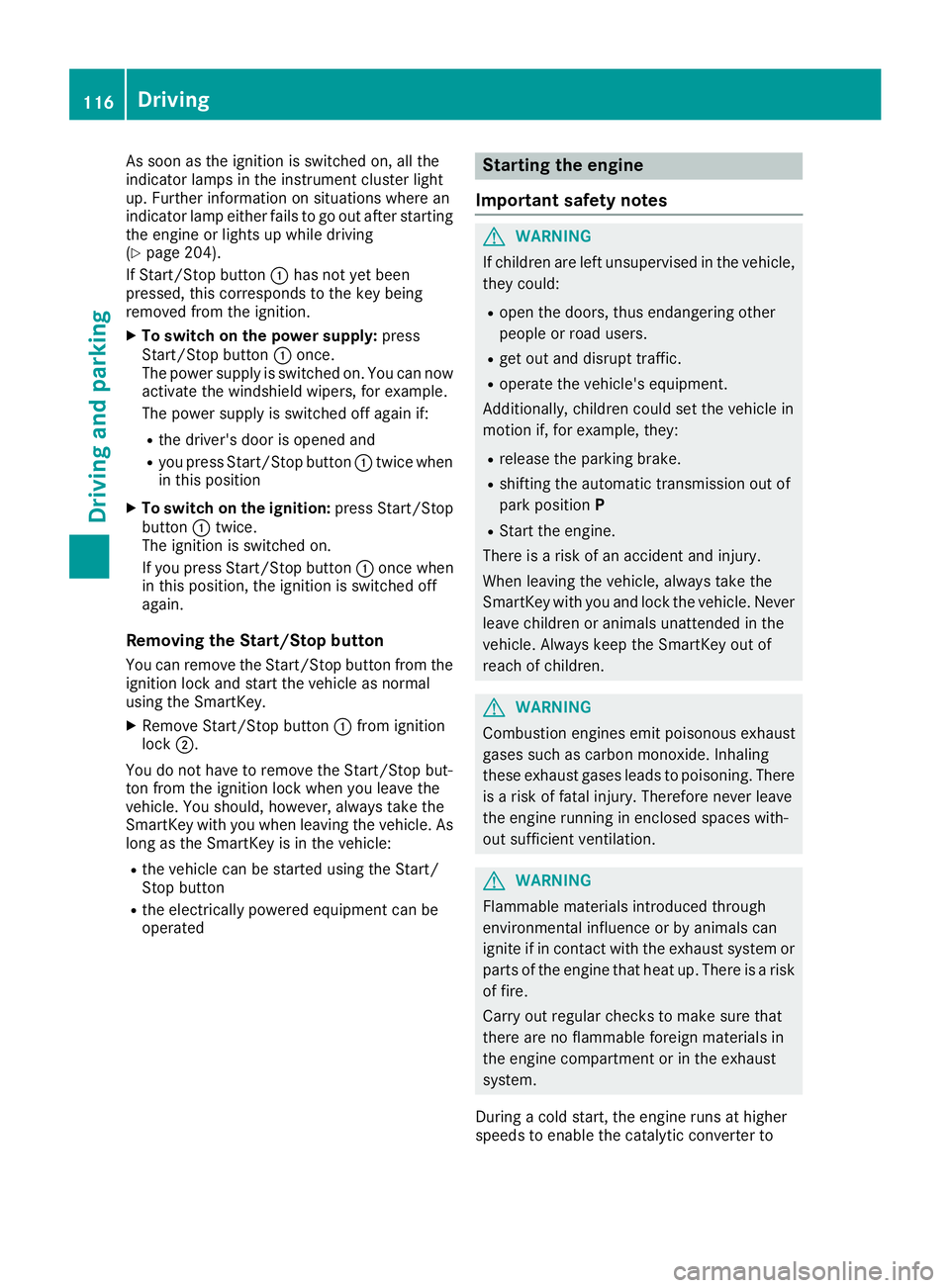
As soo na st he ignition is switched on, al lt he
indicator lamps in the instrument cluster light
up .F urther informatio nons it uations where an
indicator lamp either fails to go ou ta fte rs tarting
the engine or lights up whil ed riving
( Y
page 204).
If Start/Stop button �C ha sn ot ye tb ee n
pressed, thi sc orrespond stot he key being
remove df rom the ignition.X
To switc hont he power supply: press
Start/Stop button �C once.
The powe rs uppl yiss wi tched on. Yo uc an now
activate the windshield wipers, for example.
The powe rs uppl yiss wi tched off agai ni f:R
the driver's door is opene da ndR
yo up ress Start/Stop button �C twice when
in thi sp ositionX
To switc hont he ignition: press Start/Stop
button �C twice.
The ignition is switched on.
If yo up ress Start/Stop button �C once when
in thi sp osit ion, the ignition is switched off
again.
Removing the Start/Sto pb uttonYo uc an remove the Start/Stop button from the
ignition lock and start the vehicl easn ormal
using the SmartKey. X
Remove Start/Stop button �C from ignition
lock �D .
Yo udon ot have to remove the Start/Stop but-
ton from the ignition lock when yo ul eave the
vehicle. Yo us hould, however, always take the
SmartKe yw it hy ou when leaving the vehicle. As
long as the Sma rtKe y isint h
e vehicle:R
the vehicl ec an be started using the Start/
Stop button R
the electrically powered equipment can be
operated Starting the engine
Important safety notes
G WARNING
If children ar el ef tu nsupervised in the vehicle,
they could: R
open the doors ,t hu se ndangering other
people or roa du se rs.R
ge to ut and disrupt traffic. R
operate the vehicle's equipment.
Additionally, children could set the vehicl ei n
motion if, for example, they: R
release the parking brake. R
shifting the automatic transmission ou to f
park position P R
Star tt he engine.
There is ar is kofana ccident and injury.
Whe nl eavi ng the vehicle, always take the
SmartKe yw it hy ou and lock the vehicle. Never
leav ec hildren or animals unattended in the
vehicle. Alway sk ee pt he SmartKe yo ut of
reach of children.
G WARNING
Combustion engine se mi tp oiso nou se xhaust
gases such as carbo nm onoxide. Inhaling
thes ee xhaus tg as es lead stop oiso ning. There
is ar is koff ata li njury .T herefore neve rl eave
the engine running in enclose ds paces with-
ou ts uf ficient ventilation.
G WARNING
Flammabl em at erial si ntroduced through
environmenta li nfluence or by animals can
ignite if in contact with the exhaus ts ys tem or
parts of the engine tha th ea tu p. There is ar isk
of fire.
Carry ou tr egular checks to make sure that
ther ea re no flammabl ef oreig nm at erial si n
the engine compartment or in the exhaust
system.
During ac ol ds tart, the engine runs at higher
speed stoe nabl et he catalytic converter to116
Driving
Driving an dp arking
Page 119 of 294
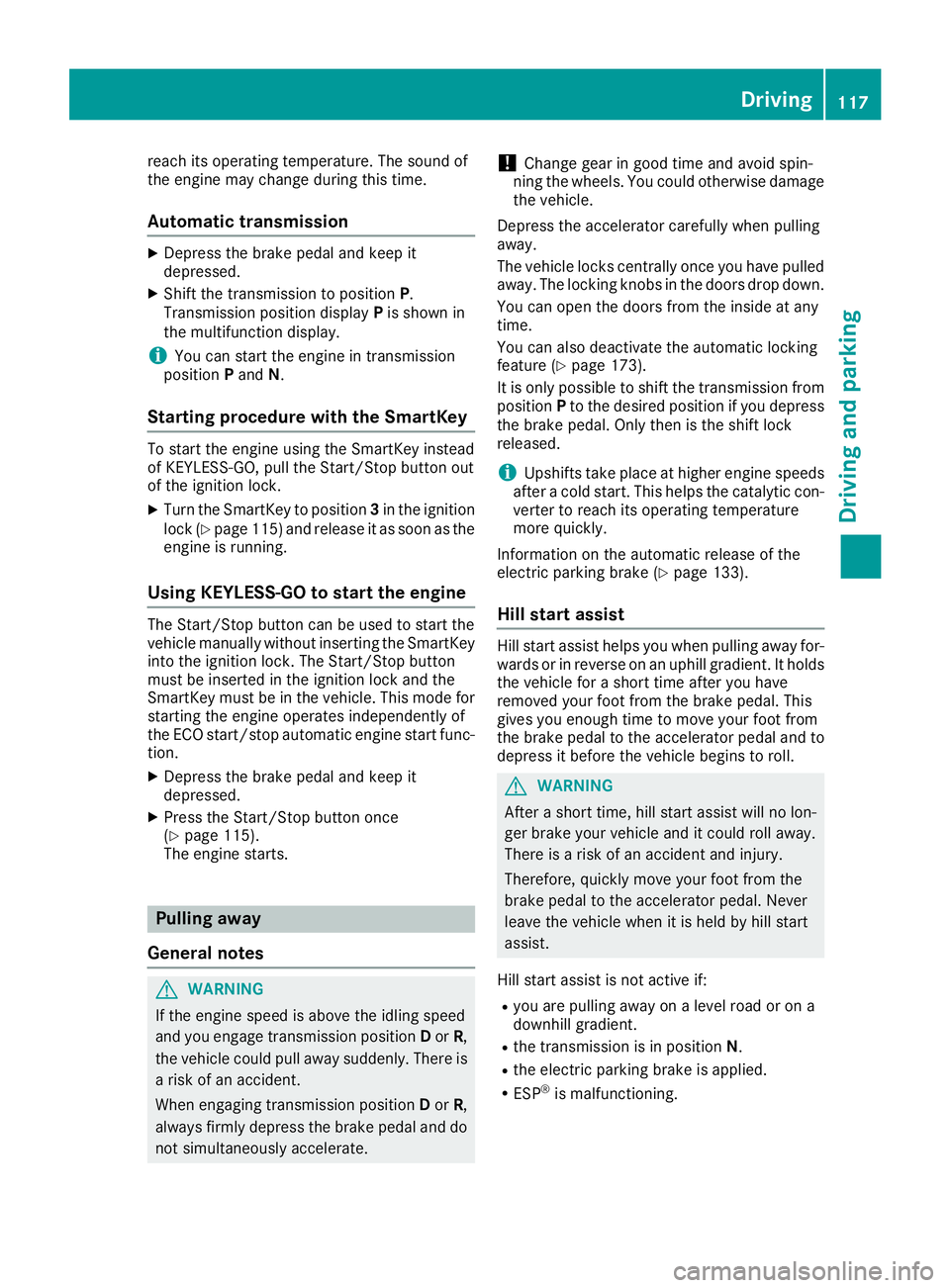
reach its operating temperature. The sound of
the engine may change during this time.
Automatic transmission X
Depress the brake peda la nd keep it
depressed. X
Shift the transmission to position P .
Transmission position display P is shown in
the multifunction display.
i You can start the engine in transmission
position P and N .
Starting procedure with the SmartKey To start the engine using the SmartKey instead
of KEYLESS-GO, pul lt he Start/Stop button out
of the ignitio nl ock.X
Turn the SmartKey to position 3 in the ignition
lock ( Y
pag e1 15) and release it as soon as the
engine is running.
Usin gK EYLE SS-GO to start the engineThe Start/Stop button can be used to start the
vehicl em anually withou ti nserting the SmartKey
into the ignitio nl ock. The Start/Stop button
must be inserted in the ignitio nl ock and the
SmartKey must be in the vehicle. This mode for
starting the engine operates independently of
the ECO start/stop automatic engine start func-
tion. X
Depress the brake peda la nd keep it
depressed. X
Press the Start/Stop button once
( Y
pag e1 15).
The engine starts.
Pulling away
General notes
G WARNING
If the engine spee disa bove the idling speed
and you engage transmission position D or R ,
the vehicl ec ould pul la wa ys uddenly .T here is
ar isk of an accident.
When engaging transmission position D or R ,
alway sf irmly depress the brake peda la nd do
not simultaneously accelerate. ! Change gea ring ood time and avoi ds pin-
ning the wheels. You could otherwise damage
the vehicle.
Depress the accelerator carefully when pulling
away.
The vehicl el ocks centrally once you have pulled
away. The locking knobs in the doors drop down.
You can open the doors from the insid eata ny
time.
You can als od eactivate the automatic locking
feature ( Y
pag e1 73).
It is only possible to shift the transmission from
position P to the desired position if you depress
the brake pedal. Only then is the shift lock
released.
i Upshifts take place at highe re ngine speeds
after ac old start. This help st he catalytic con-
verter to reach its operating temperature
more quickly.
Information on the automatic release of the
electric parking brake ( Y
pag e1 33).
Hill start assist Hill start assist help sy ou when pulling awa yf or-
ward sorinr everse on an uphill gradient. It holds
the vehicl ef or as hort time after you have
removed you rf oot from the brake pedal. This
gives you enoug ht ime to move you rf oot from
the brake peda ltot he accelerator peda la nd to
depress it before the vehicl eb egins to roll.
G WARNING
After as hort time, hill start assist wil lnol on-
ger brake you rv ehicl ea nd it could roll away.
There is ar isk of an accident and injury.
Therefore, quickly move you rf oot from the
brake peda ltot he accelerator pedal. Never
leave the vehicl ew hen it is held by hill start
assist.
Hill start assist is not active if: R
you are pulling awa yonal evel road or on a
downhill gradient. R
the transmission is in position N .R
the electric parking brake is applied. R
ESP ®
is malfunctioning. Driving 117
Driving and parking Z
Page 121 of 294
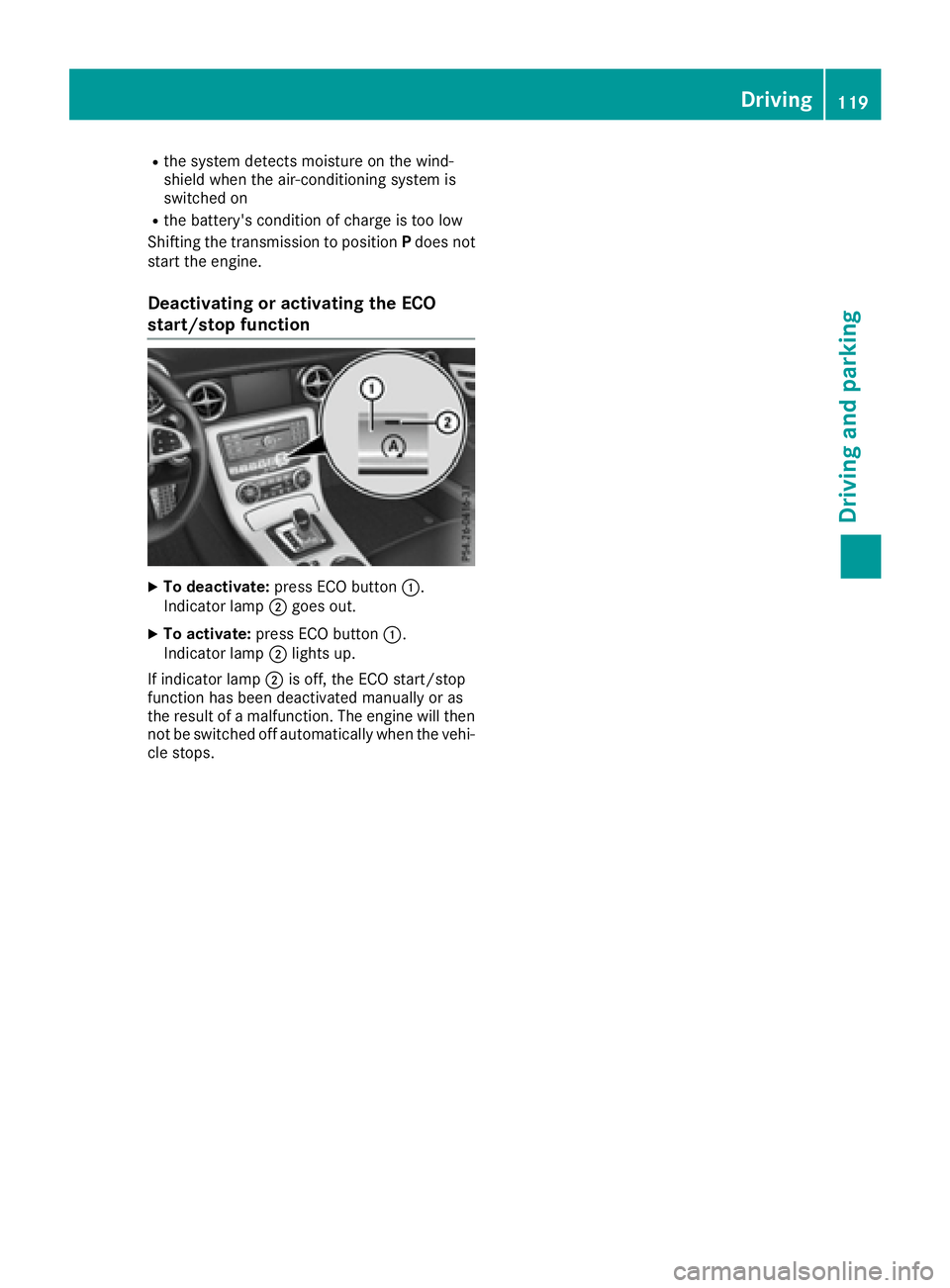
R
the syste md et ects moisture on the wind-
shiel dw he nt he air-conditioning syste mi s
switched on R
the battery's condition of charge is too low
Shiftin gt he transmission to position P does not
start the engine.
Deactivatin gora ct ivatin gt he ECO
start/sto pf unctionX
To deactivate: press ECO button �C .
Indicato rl am p �D goes out.X
To activate: press ECO button �C .
Indicato rl am p �D lights up.
If indicator lamp �D is off ,t he ECO start/stop
functio nh as been deactivated manuall yora s
the resul tofa malfunction. The engine will then
not be switched off automaticall yw he nt he vehi-
cle stops. Driving 119
Dr ivi ng an dp arking Z